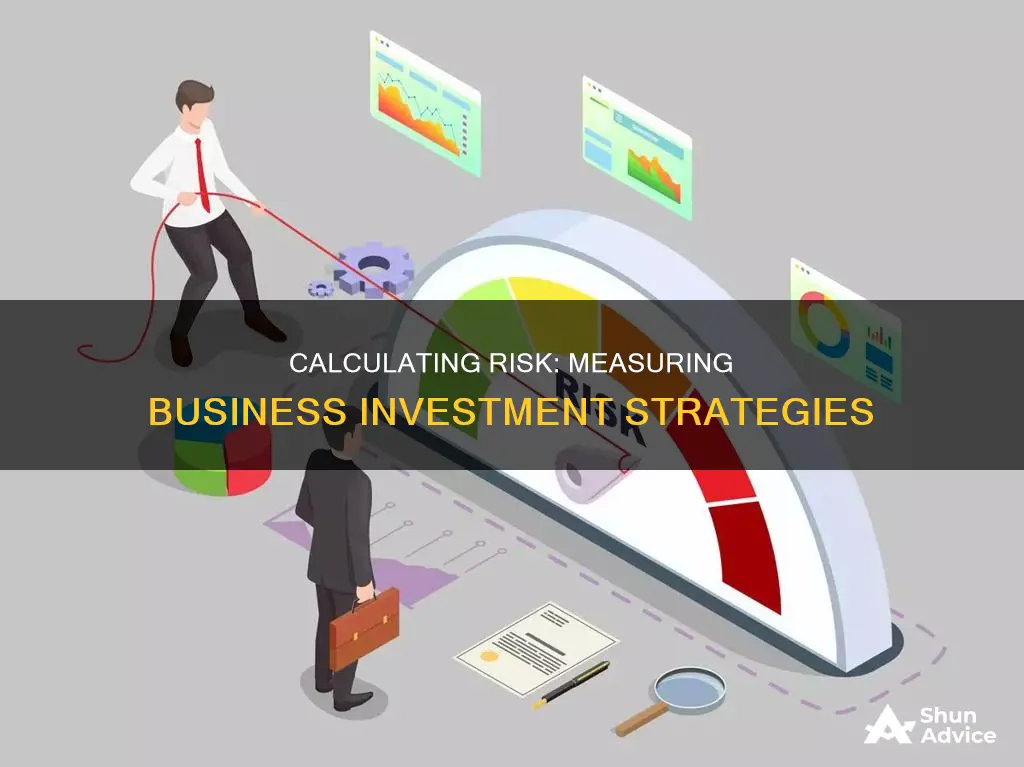
Risk is an inherent part of business investment, and understanding how to measure it is crucial for making informed decisions. Risk measures are statistical tools that predict investment risk and volatility, playing a significant role in modern portfolio theory (MPT). MPT is a standard methodology for evaluating investment performance relative to a benchmark index. There are five principal risk measures: alpha, beta, R-squared, standard deviation, and the Sharpe ratio. These measures help investors assess the risk associated with potential investments and determine if they align with their risk tolerance and financial goals. While numbers don't tell the whole story, they provide valuable insights for decision-making.
What You'll Learn

Alpha, Beta, R-squared, Standard Deviation, and Sharpe Ratio
There are five principal risk measures that can be used individually or together to assess the risk associated with investments: alpha, beta, R-squared, standard deviation, and the Sharpe ratio. These measures help determine a fund's performance against a benchmark index, such as the S&P 500, and help investors understand the risk-reward parameters of their investments.
Alpha measures the risk-adjusted performance of an investment relative to a benchmark index or the market. It quantifies the excess return of an investment compared to the benchmark's return. A positive alpha indicates outperformance, while a negative alpha suggests underperformance.
Beta, or the beta coefficient, assesses the volatility or systematic risk of a security or portfolio relative to the market. It is calculated using regression analysis and indicates how sensitive an investment's return is to market movements. A beta of 1 indicates the investment moves in tandem with the market, values below 1 suggest lower volatility, and values above 1 indicate higher volatility.
R-squared (R2) quantifies the correlation between a fund's performance and a benchmark index. It represents the percentage of a fund's performance attributable to the benchmark's movements. R2 values range from 0 to 100, with higher values indicating a stronger correlation.
Standard deviation measures the dispersion of an investment's returns from its mean or average. It quantifies the volatility of an investment by assessing how much the returns deviate from the expected normal returns. A higher standard deviation indicates greater volatility but not necessarily greater risk, as it does not differentiate between gains and losses.
The Sharpe ratio, developed by Nobel laureate economist William Sharpe, measures the risk-adjusted performance of an investment. It is calculated by subtracting the risk-free rate of return (such as a US Treasury Bond) from the investment's return and then dividing it by the investment's standard deviation. The Sharpe ratio helps investors understand if an investment's returns are due to wise decisions or excessive risk-taking. A higher Sharpe ratio indicates better risk-adjusted performance.
Investment Portfolio AES: A Comprehensive Guide
You may want to see also

Risk tolerance and capacity
Risk tolerance and risk capacity are two distinct concepts that are often used interchangeably but carry different meanings. They are crucial factors in crafting a balanced and effective investment strategy.
Risk Tolerance
Risk tolerance refers to an individual's psychological willingness to take on risk. It is about emotional and psychological comfort with risk and is influenced by personality, past experiences, need for stability, and various behavioural biases. Tolerance is subjective and varies from person to person, but it can also change over time due to life events, age, and economic conditions. Younger investors, for example, may be more willing to take on risks as they have more time to recover from potential losses. Tolerance can be assessed through psychological questionnaires or self-reflection.
Risk Capacity
On the other hand, risk capacity relates to the financial ability to endure potential losses. It is determined by concrete financial circumstances like income, debt, insurance coverage, dependents, and time horizon. Unlike tolerance, capacity is not influenced by emotions but rather by objective financial factors. It sets a tangible boundary on the level of risk one can afford to take, regardless of their willingness to engage in riskier ventures.
Achieving Harmony
It is important to achieve harmony between risk tolerance and capacity to ensure a sustainable and fruitful investment journey. This involves understanding one's risk profile, diversifying investments, and regularly reviewing and adjusting one's financial plan.
Understanding Portfolio Investment: Definition and Key Concepts
You may want to see also

Market risk
There are several methods to measure market risk:
Volatility
Volatility is the most common measure of risk. It is defined as: "How much will the price of an asset move, with a 68% probability?". While this definition may seem strange, the 68% value is based on natural observations. Volatility allows for easy comparison between two stocks or different asset classes. For example, if stock A has 20% volatility and stock B has 10% volatility, the risk (and upside) of stock A is double that of stock B.
Value-at-Risk (VaR)
VaR is a statistical measure of the potential loss in value of a risky asset or portfolio over a given period, for a given confidence interval. It provides a single, easy-to-understand number that encapsulates the downside risk of an investment. For example, a portfolio of investments with a one-year 10% VaR of $5 million has a 10% chance of losing $5 million over that year. VaR can be calculated using several methods, including historical data, the variance-covariance method (assuming a normal distribution of returns), and Monte Carlo simulations.
Conditional Value-at-Risk (CVaR)
CVaR addresses some of the limitations of VaR by measuring the expected loss if the loss exceeds the VaR. This provides information about the severity of losses beyond the VaR threshold. For example, if a risk manager calculates an average loss of $10 million for the worst 1% of outcomes for a portfolio, the CVaR is $10 million for this 1% of the investment distribution curve.
Standard Deviation
Standard deviation is a statistical measure that quantifies the dispersion of data from its mean. In finance, it is used to gauge the historical volatility of an investment relative to its annual rate of return. A stock with a high standard deviation experiences greater volatility and is therefore riskier.
Beta
Beta measures the volatility or systematic risk of a fund in comparison to the market or a selected benchmark index. A beta of one indicates the fund is expected to move in conjunction with the benchmark. Betas below one are considered less volatile, while those above one are considered more volatile.
The Allure of Investment Management: Strategies, Challenges, and Rewards
You may want to see also

Risk analysis
Understanding Risk and Its Measurement
Risk refers to the possibility of investments underperforming or deviating from expectations. It is essential to distinguish between two types of risk: risk tolerance and risk capacity. Risk tolerance pertains to an investor's emotional and mental ability to handle potential losses, influenced by their beliefs, personality, and investment experience. On the other hand, risk capacity is more objective, based on financial circumstances, age, and the time available for investing.
To measure risk, investors and advisors can utilise tools such as alpha, beta, R-squared, standard deviation, and the Sharpe ratio. These statistical measures provide valuable insights into the volatility and potential losses associated with investments.
Types of Investment Risks
There are several types of investment risks that can impact a business's performance:
- Economic Risk: This involves macroeconomic factors such as economic cycles, inflation, unemployment, and interest rates, which can affect entire industries or even the global economy.
- Industry Risk: Industry-specific risks include economic factors and technological advancements that influence an entire industry. For example, an increase in oil prices can significantly impact the airline industry.
- Company Risk: Specific characteristics of a company, such as debt financing, inventory management, and labour relationships, can make it more or less vulnerable to economic and industry risks.
- Asset Class Risk: Different asset classes, such as stocks, bonds, commodities, derivatives, real estate, and collectibles, carry varying levels of risk and potential returns.
Risk Management Techniques
Effective risk management goes beyond the mere application of financial models. It requires the integration of judgment and experience to utilise models appropriately and recognise their limitations. Additionally, it is crucial to supplement or substitute models with alternative approaches when necessary.
Value at Risk (VaR)
Value at risk (VaR) is a critical concept in risk management, representing the minimum expected loss over a specific period, given certain market conditions. VaR can be estimated using three primary methods: the parametric method, the historical simulation method, and the Monte Carlo simulation method. However, it is important to acknowledge that VaR has limitations and can be sensitive to various factors and assumptions.
Constraints and Scenario Measures
Risk management also employs constraints such as risk budgeting, position limits, scenario limits, and stop-loss limits to control and mitigate risks. Additionally, scenario measures, including stress tests, evaluate portfolio performance under high-stress market conditions, utilising historical or hypothetical scenarios.
Application of Risk Measures by Different Organisations
Different types of organisations utilise risk measures in varied ways:
- Banks: Banks use risk tools to assess liquidity, asset/liability mismatches, investment portfolio losses, leverage ratios, and interest rate sensitivities.
- Asset Managers: They focus on volatility, the probability of loss, and the potential to underperform a benchmark.
- Pension Funds: Pension funds evaluate asset/liability mismatches and surplus at risk.
- Insurers: Property and casualty insurers maintain defined asset allocation ranges, while life insurers assess investment portfolio exposures, annuity liabilities, and potential stress losses.
In conclusion, risk analysis in business investment is a complex and dynamic process that requires a combination of quantitative measures, experience, and adaptive strategies to make informed decisions and mitigate potential losses.
Understanding Risk in Investment Management
You may want to see also

Risk management
Risk Measurement Techniques
Several statistical measures can be employed to quantify investment risk, including alpha, beta, R-squared, standard deviation, and the Sharpe ratio. These tools enable investors to assess the historical volatility and potential risks associated with their investments. Alpha, for instance, measures the excess return of an investment relative to a benchmark index, indicating whether it outperforms or underperforms the market. Beta quantifies the volatility of an investment compared to the market, with a beta of 1 indicating that the investment moves in tandem with the market. R-squared determines the percentage of an investment's movement attributable to its benchmark index, reflecting the correlation between the two. The Sharpe ratio evaluates the return on an investment relative to the risk undertaken, providing insight into whether the returns are a result of prudent investing or excessive risk-taking. Lastly, standard deviation measures the dispersion of an investment's returns from its average, indicating its volatility.
Risk Analysis in Capital Investment
Business executives face complex decisions when choosing among alternative capital investment opportunities. Risk analysis plays a pivotal role in guiding these choices by evaluating the multitude of risks involved. This involves assessing the impact of various assumptions and their inherent uncertainties, which, when combined, can lead to significant overall uncertainty. Effective risk analysis provides executives with valuable insights to make well-informed investment decisions, launch new products, or avoid overcapacity.
Market Risk and Credit Risk
Market risk arises from fluctuations in stock prices, interest rates, exchange rates, and commodity prices. It is essential for organizations to identify and measure this risk to ensure alignment with their desired risk exposure. Financial models, such as investment risk models, are valuable tools for understanding how different risk factors can impact portfolio values and potential gains or losses. Credit risk, distinct from market risk, pertains to the possibility of loss due to the failure of a counterparty to fulfil their payment obligations.
Risk Tolerance and Capacity
Understanding risk tolerance and risk capacity is crucial for investors. Risk tolerance refers to an investor's emotional and mental ability to withstand potential investment losses and their comfort level with market volatility. It is influenced by factors such as beliefs, personality, and investment experience. On the other hand, risk capacity pertains to how much risk an investor can afford to take. This is determined by financial circumstances, age, and the time horizon for investments. It is important to strike a balance between risk tolerance and risk capacity to ensure that the level of risk undertaken aligns with the investor's financial goals and emotional comfort.
Risk Mitigation Strategies
While risk management involves understanding and measuring risk, it also extends to risk mitigation. This includes applying judgment and experience in utilizing financial models, recognizing their strengths and limitations, and knowing when to supplement or substitute models. Additionally, effective risk management entails the use of constraints such as risk budgeting, position limits, scenario limits, and stop-loss limits. These constraints provide a framework for managing risk within defined boundaries and help drive appropriate risk-related actions.
Equities: A Smart Investment Choice?
You may want to see also
Frequently asked questions
Risk in business investment refers to the possibility of an investment performing below expectations. Different investments carry different levels of risk, and this risk can be measured and analysed to make informed investment decisions.
There are several statistical measures and models used to quantify and assess investment risk. These include alpha, beta, R-squared, standard deviation, Sharpe ratio, and value at risk (VaR). Each measure provides a unique perspective on the risk associated with an investment.
Investment risk is influenced by various factors, including economic conditions, industry-specific events, company-specific characteristics, and market fluctuations. These factors can impact the performance of an investment and deviate from expected returns.
Effective risk management involves applying judgement and experience in using financial models. It is essential to understand the strengths and limitations of different models and be prepared to supplement or substitute them when necessary. Additionally, risk budgeting, position limits, scenario limits, and stop-loss limits are tools used to manage and mitigate investment risk.







